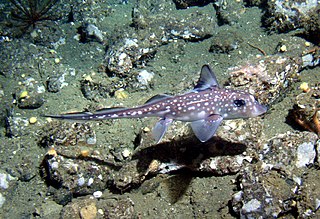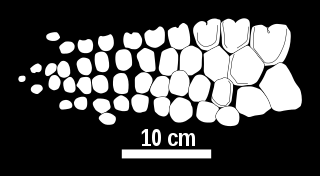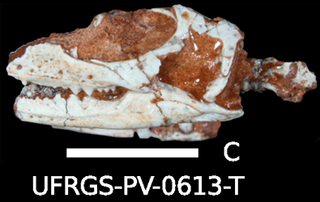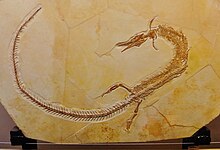
The Jurassic is a geologic period and stratigraphic system that spanned from the end of the Triassic Period 201.4 million years ago (Mya) to the beginning of the Cretaceous Period, approximately 145 Mya. The Jurassic constitutes the middle period of the Mesozoic Era as well as the eighth period of the Phanerozoic Eon and is named after the Jura Mountains, where limestone strata from the period were first identified.

Chimaeras are cartilaginous fish in the order Chimaeriformes, known informally as ghost sharks, rat fish, spookfish, or rabbit fish; the last three names are not to be confused with rattails, Opisthoproctidae, or Siganidae, respectively.

Rhynchocephalia is an order of lizard-like reptiles that includes only one living species, the tuatara of New Zealand. Despite its current lack of diversity, during the Mesozoic rhynchocephalians were a speciose group with high morphological and ecological diversity. The oldest record of the group is dated to the Middle Triassic around 238 to 240 million years ago, and they had achieved global distribution by the Early Jurassic. Most rhynchocephalians belong to the group Sphenodontia ('wedge-teeth'). Their closest living relatives are lizards and snakes in the order Squamata, with the two orders being grouped together in the superorder Lepidosauria.

The Trachypachidae are a family of beetles that generally resemble small ground beetles, but that are distinguished by the large coxae of their rearmost legs. There are only six known extant species in the family, with four species of Trachypachus found in northern Eurasia and northern North America, and two species of Systolosoma in Chile and Argentina. They were much more diverse in the past, with dozens of described species from the Mesozoic.

Sphenodontidae is a family within the reptile group Rhynchocephalia, comprising taxa most closely related to the living tuatara. Historically the taxa included within Sphenodontidae have varied greatly between analyses, and the group has lacked a formal definition. Cynosphenodon from the Jurassic of Mexico has consistently been recovered as a close relative of the tuatara in most analyses, with the clade containing the two and other very close relatives of the tuatara often called Sphenodontinae. The herbivorous Eilenodontinae, otherwise considered part of Opisthodontia, is considered to be part of this family in many recent studies as the sister group to Sphenodontinae. The earliest Sphenodontines are known from the Early Jurassic of North America, with other remains known from the Late Jurassic of Europe, the Late Cretaceous and possibly Paleocene of South America and the Miocene-recent of New Zealand. Sphenodontines are characterised by a complete lower temporal bar caused by the fusion of a forward directed process (extension) of the quadrate/quadratojugal and the jugal, which was an adaptation for reducing stress in the skull during hard biting. Other synapomorphies of Sphenodontinae include the presence of nasal foramina, a posterodorsal process of the coronoid of the lower jaw, the present of caniniform successional teeth at the front of the jaws, the presence of flanges on the posterior parts of teeth at back of the lower jaw, and an expanded radial condyle on the humerus. Like modern tuatara, members of Sphenodontinae were likely generalists with a carnivorous/insectivorous diet.

Goniopholis is an extinct genus of goniopholidid crocodyliform that lived in Europe and North America during the Late Jurassic and Early Cretaceous. Like other goniopholidids, it resembled living crocodilians, and probably had a similar ecology as semi-aquatic ambush predators.

Anurognathidae is a family of small, short-tailed pterosaurs that lived in Europe, Asia, and possibly North America during the Jurassic and Cretaceous periods. Five genera are known: Anurognathus, from the Late Jurassic of Germany; Jeholopterus, from the Middle to Late Jurassic of China; Dendrorhynchoides, from the Middle Jurassic of China; Batrachognathus, from the Late Jurassic of Kazakhstan; and Vesperopterylus, from the Early Cretaceous of China. Bennett (2007) suggested that the holotype of Mesadactylus, BYU 2024, a synsacrum, belonged to an anurognathid, though this affinity has been questioned by other authors. Mesadactylus is from the Late Jurassic Morrison Formation of the United States. Indeterminate anurognathid remains have also been reported from the Middle Jurassic Bakhar Svita of Mongolia and the Early Cretaceous of North Korea.

Pleurosaurus is an extinct genus of aquatic reptiles belonging to the order Rhynchocephalia. Pleurosaurus fossils have primarily been discovered in the Solnhofen Limestone of Bavaria, Germany and the Canjuers lagerstatte near Canjuers, France, both dating to the Late Jurassic. It contains two species, P. goldfussi and P. ginsburgi.

Compsognathidae is a family of coelurosaurian theropod dinosaurs. Compsognathids were small carnivores, generally conservative in form, hailing from the Jurassic and Cretaceous Periods. The bird-like features of these species, along with other dinosaurs such as Archaeopteryx inspired the idea for the connection between dinosaur reptiles and modern-day avian species. Compsognathid fossils preserve diverse integument — skin impressions are known from four genera commonly placed in the group, Compsognathus, Sinosauropteryx, Sinocalliopteryx and Juravenator. While the latter three show evidence of a covering of some of the earliest primitive feathers over much of the body, Juravenator and Compsognathus also show evidence of scales on the tail or hind legs. "Ubirajara jubatus", informally described in 2020, had elaborate integumentary structures on its back and shoulders superficially similar to the display feathers of a standardwing bird-of-paradise, and unlike any other non-avian dinosaur currently described.

Excalibosaurus is a monotypic genus of marine prehistoric reptiles (ichthyosaurs) that lived during the Sinemurian stage of the Early Jurassic period in what is now England. It is characterized by the extreme elongation of the rostrum, with the lower jaw about three-quarters the length of the upper jaw, giving the animal a swordfish-like look. The only known species is Excalibosaurus costini.

Palaeopleurosaurus is an extinct genus of diapsid reptiles belonging to the group Sphenodontia.

Brachyrhinodon is an extinct genus of sphenodontian from the Late Triassic Lossiemouth Sandstone of Scotland.

Chacaicosaurus is a genus of neoichthyosaurian ichthyosaur known from the Middle Jurassic of Argentina. The single known specimen of this genus was excavated from the Los Molles Formation in Neuquén Province, and is housed at the Museo Olsacher under the specimen number MOZ 5803. This specimen consists of a skull, forelimb, some vertebrae, and some additional postcranial elements. The genus was named by Marta Fernández in 1994, and contains a single species, Chacaicosaurus cayi, making it the first named distinctive ichthyosaur from the Bajocian stage. It is a medium-sized ichthyosaur with a very long snout, which bears a ridge running along each side. The forelimbs of Chacaicosaurus are small and contain four main digits.

Clevosaurus is an extinct genus of rhynchocephalian reptile from the Late Triassic and the Early Jurassic periods. Species of Clevosaurus were widespread across Pangaea, and have been found on all continents except Australia and Antarctica. Five species of Clevosaurus have been found in ancient fissure fill deposits in south-west England and Wales, alongside other sphenodontians, early mammals and dinosaurs. In regards to its Pangaean distribution, C. hadroprodon is the oldest record of a sphenodontian from Gondwana, though its affinity to Clevosaurus has been questioned.

Gephyrosaurus is an extinct genus of lepidosaurian reptile known from the Late Triassic to Early Jurassic of the United Kingdom. It is generally considered to be one of the most primitive members of the clade Rhynchocephalia.
Sphenocondor is an extinct genus of sphenodontian reptile from the Early Jurassic Cañadón Asfalto Formation of Argentina. It is known from a nearly complete lower jaw.

Clevosaurs are an extinct group of rhynchocephalian reptiles from the Triassic and Jurassic periods.

Sapheosaurs are an extinct group of rhynchocephalian reptiles from the Late Jurassic period. "Sapheosaurs" is an informal name for a group of rhynchocephalians closely related to the genus Sapheosaurus. It was first recognized as a group containing multiple genera by Hoffstetter in 1955. The group has sometimes been given a formal taxonomic name as the family Sapheosauridae, although in some analyses this group belongs to the family Sphenodontidae and thus cannot be assigned its own family. They were fairly advanced rhynchocephalians which may have had semiaquatic habits.

Ginglymodi is a clade of ray-finned fish containing modern-day gars (Lepisosteidae) and their extinct relatives in the order Lepisosteiformes, the extinct orders Semionotiformes and Kyphosichthyiformes, and various other extinct taxa. Ginglymodi is one of the two major subgroups of the infraclass Holostei, the other one being Halecomorphi, which contains the bowfin and eyespot bowfin and their fossil relatives.

Microsphenodon is an extinct genus of sphenodontian from the Late Triassic of Brazil. The type species is Microsphenodon bonapartei. It is a small sphenodontian with a skull roughly 20 mm long, and represents a unique mosaic of characteristics shared by both early diverging sphenodontians and eusphenodontian characters. Specimens of this taxon were first identified by Bonaparte and Sues (2006) but were misidentified as juvenile Clevosaurus brasiliensis, characteristics such as differences in the configuration of the teeth on the palate, and the unique form of tooth implantation seen in C. brasiliensis, helped differentiate these two co-occurring sphenodontian taxa.




















